Healthcare mobile app development—
Is it a good business idea?
Let me share an interesting number with you: in 2024, there were about 12,000 healthcare apps available for iPhones.
That’s a lot, right?
Well, today, we estimate this number to be well over 350,000.
That’s extraordinary, of course, and it’s also the best proof of why investing in healthcare mobile app development is an idea worth exploring. And that’s why we created this guide—to give you all the info you need to start.
Get started:
- What is a healthcare mobile app?
- Healthcare mobile app development as a business idea
- Types of healthcare mobile apps
- Examples of successful healthcare mobile apps
- Healthcare mobile app development: the process
- How much does healthcare mobile application development cost?
- How to find a healthcare mobile app development company
Get professional software developers to create your healthcare mobile app.
What is a healthcare mobile app?
A healthcare mobile app is a mobile application designed to help the general public to improve their health and well-being by providing access to education, helping to reinforce previously received training, or automating administrative processes of offices in a healthcare setting.
A healthcare mobile app development process is a process that involves planning, coding, and designing an app intended for healthcare purposes. This process begins with a market research and ends with the final release of the app to the public.
Examples of commonly used healthcare mobile apps include:
- Medical dictionaries
- Sleep monitoring apps
- Fitness and wellbeing apps
- Healthy nutrition apps
- Cardiographs on smartphones
- Doctor app appointment reminders
- Nursing job board apps
- Healthcare accounting software
To get an idea of how such applications work, check out this video for Headspace, a super popular wellbeing app (10+ million downloads):
💡 There is a difference between a healthcare app and a medical app.
FDA states that medical apps are apps that turn a mobile device into a medical device used for diagnosis and treatment. The primary users of mobile medical apps are doctors (and often patients). Healthcare apps, on the other hand, are mostly intended for the general public’s education and the facilitation of beneficial practices.
Healthcare mobile app development as a business idea
The exploding number of available healthcare apps is surely a win for healthcare software development as a business idea.
But let’s dig a little bit deeper.
Just like with other software development projects, we need to take a look at our market and target audience.
Here are a few stats you need to know:
As of April 2023, there were 54,000+ healthcare apps available on Google Play Store. As you can see below, it’s a small decrease compared to Q4 of 2021—the global crisis slowed down the growth. Still, we see that the number is slowly growing again:

Next—
The U.S. market of healthcare apps was estimated at 43.5 billion in 2022 and is projected to increase by about 9.5% every year:

These two stats show us that the market is growing, slowly but surely.
Here are more figures to back this up:
- Over 84 million U.S. adults use health and fitness apps [source]
- $270 million is the global consumer spending for mental wellness apps [source]
- About 91% of patients who use online portals to communicate with healthcare providers prefer mobile apps [source]
- Over 61% of smartphone owners in the U.S. have used them to get health-related information [source]
- $209 million is the gross revenue generated by health and fitness apps in the U.S. [source]
All these impressive numbers suggest one thing: investing in app development for healthcare is indeed an idea worth exploring.
Related content: 💡 Artificial Intelligence For Healthcare: 5 Trends To Watch
Types of healthcare mobile apps
If you’re considering investing in healthcare mobile app development, you need to also know what options of apps you have.
The most common types of healthcare mobile apps are:
- Medication reminders & info
- Lifestyle & stress management
- Diet & nutrition management
- Women’s health and pregnancy
- Healthcare insurance
- Doctor on demand apps
- Medical records apps
- Medicine delivery apps
- Hospital process automation
All healthcare mobile apps fall into a few categories:
- Health condition management
- Wellness management
- Apps for hospital management
Examples of successful healthcare mobile apps
As you can imagine, there’s lots of popular and successful mobile apps in the healthcare industry.
Here are our picks of the top healthcare mobile apps.
1. Fooducate
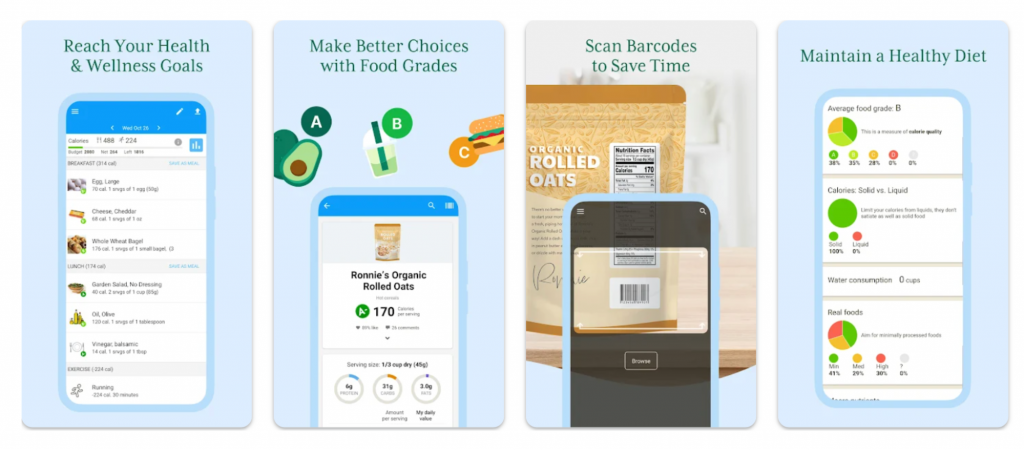
Type: Calorie counter
Downloads: 1+ million (Google Play Store)
Pricing: Free subscription available; Premium: from $4.99/yr to $74.99/yr.
2. Headspace
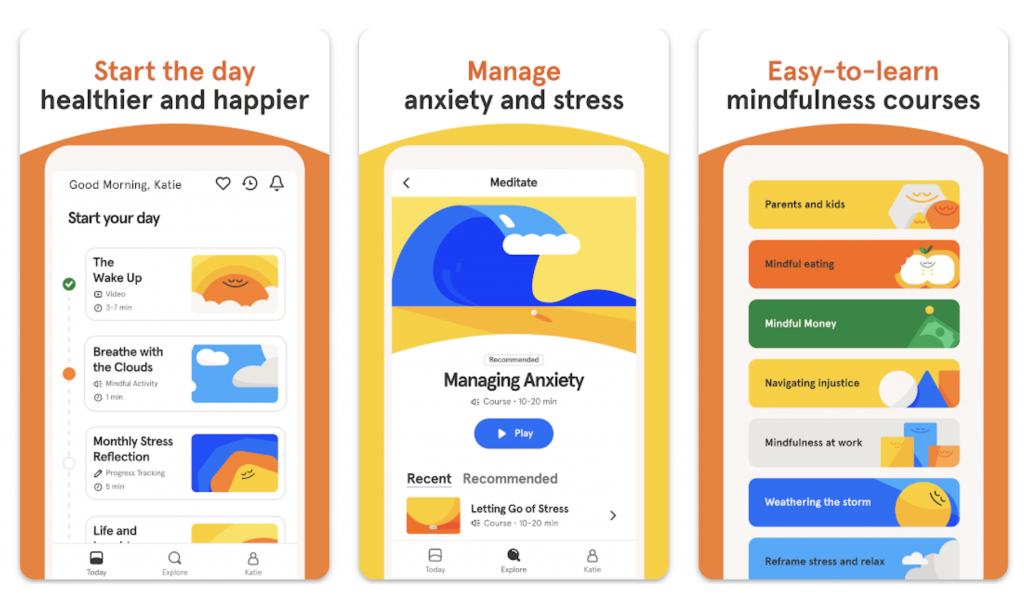
Type: Meditation app
Downloads: 10+ million (Google Play Store)
Pricing: Free plan; Premium: $12.99/yr to $69.99/yr
3. Fitify
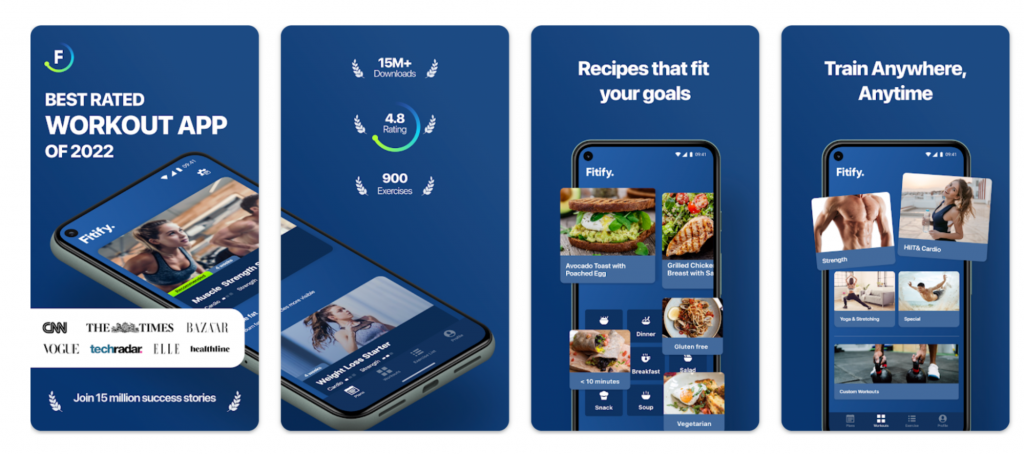
Type: Fitness
Downloads: 10+ million (Google Play Store)
Pricing: Free plan; Premium: $77/yr
4. MyTherapy Pill Reminder
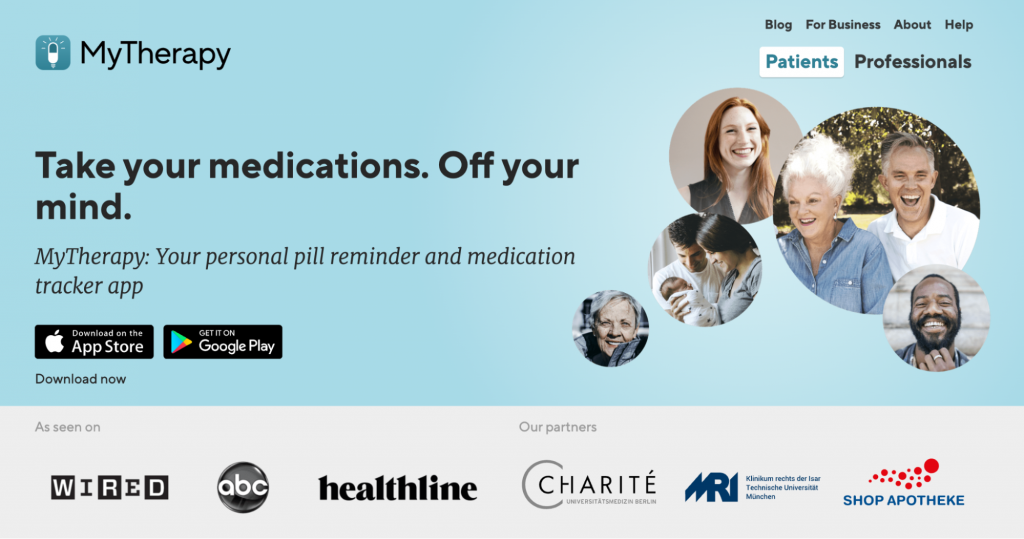
Type: Medication reminder
Downloads: 5+ million (Google Play Store)
Pricing: Free plan; In-app purchases available
5. Doctor Anywhere

Type: Doctor on-demand app
Downloads: 1+ million (Google Play Store)
Pricing: Free plan; In-app purchases available
Want to see more apps?
👉 App ideas for startups
👉 Best live streaming apps
👉 Top clothing apps for iOS and Android
Health mobile app development success story: Dare

Let’s look at this example of app development for healthcare in more detail.
Dare is an app that our developers at IDAP Group created:
👉 Read about how we developed Dare
App name: Dare
Links: Google Play Store | App Store
Rating: 4.8 (App Store); 4.5 (Google Play Store)
Description: Dare is an app that people can use to learn simple and effective strategies to relieve anxiety and panic attacks.
Here’s how it works:
First, users choose what they’re struggling with (here are the problems they can select):

Then—
They get many useful resources (audio and video) to help them relax. For example, they can get audio with a therapist telling them in a calm voice how to relieve anxiety. Downloading audio and videos is possible, too, and is helpful to have access to them at all times.
There are also some helpful features for crisis situations. For example, you can use the app to de-escalate a panic attack by following a series of steps, also narrated by a calm, soothing voice:

Many of Dare’s features are free, but there’s also a paid version with extra resources.
See more examples of software developed by IDAP:
Healthcare mobile app development: the process
As you can imagine, mobile healthcare software development is a process that includes many steps. But if you follow a proven strategy for building healthcare apps, your project will be successful.
Here are seven key steps of healthcare mobile app development:
- Study your market
- Learn about target users
- Decide on the app type and features
- Hire a team of developers
- Create an app design
- Deliver an MVP
Now, let’s look at these in more detail.
1. Study your market
You can save tons of money and time by studying your market and validating your idea first—before committing to anything.
Market research for a healthcare mobile app should answer these questions:
- What’s the goal of the app?
- Does the goal meet a real need on the market?
- Are you going to be targeting a wide user base or a more niche one?
- Who are the most successful competitors?
- Will your app have any unique differentiators from the competitors?
- What external factors can interfere with your healthcare app development?
To answer these questions—
You have a few ways to go.
You can explore reputable websites like Pew Research Center and conduct surveys and interviews.
For example—
These are the main health and wellbeing goals that are on the minds of your potential users right now.
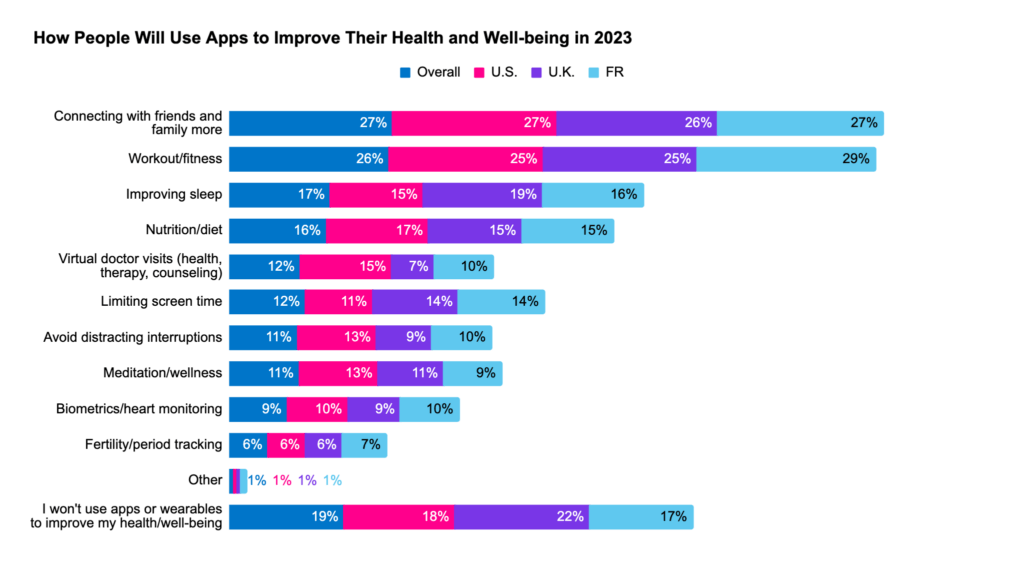
Next—
You can check out competitors’ apps and do a SWOT analysis.
If you’d like to develop a guided meditation app, for example, you should check out professional reviews of your competitors from psychologists (because they often mention the shortcomings, too).
Example:
These are the pros and cons of Headspace (a popular meditation app) from Dr. Nancy A. Haug, a Professor of psychology:

Get more info about market research:💡 Mobile app development process: a step-by-step guide
2. Learn about target users
The goal of this step is to have a clear definition of your healthcare app’s market.
Let me explain what I mean by “clear” with an example. If we stick to the guided meditation example, this is what the basic definition could look like:
“Our target users are people:
- Of all ages looking to improve sleep and relieve stress
- Who want to begin exploring meditation and mindfulness for the first time
- Who have time only for short (about 15 mins) single-session meditations a day
- Who are looking for ideas to apply mindfulness in their everyday activities to improve their work performance”
In addition to this definition, the profile of the target user of your healthcare mobile app could also include such points as location, occupation, hobbies, level of education, and income.
For example, CollaborateMD, which helps healthcare businesses improve patient care and revenue, targets people who require appointment reminders (among other things). Therefore, they market themselves as an organization and practice management solution.
3. Decide on the app type and features
There are so many types of healthcare mobile apps you can develop. We mentioned many of them earlier in this post, but let’s list some of them once again here. Also, let’s add the most important features to give you a better idea:

Related content:💡Typical challenges in the software development process
4. Hire a team of developers
At this point, you just need app developers. One way to begin the healthcare mobile app development process is to hire a dedicated software development team.
Hiring a dedicated team simply means outsourcing the development tasks to developers overseas. The big advantage is the cost reduction—in some cases, hiring this way could be up to 70% less expensive compared to the cost of developers in the U.S.
Outsourcing partners also take care of things like:
- Finding developers. You get a custom team with all the expertise and experience needed for your healthcare mobile app project
- Infrastructure expenses. Your vendor will take care of the IT infrastructure so you can focus on the business side of the project
- Regular reporting and monitoring. You’ll be presented with all the info on your healthcare application development progress on a regular basis
And the best thing about outsourcing healthcare software development is that you manage everything with a software development project manager, who’ll be your sidekick, taking care of the processes and reporting to you.
Related content:
- What is software development outsourcing?
- Guide to offshore software development
- How to hire an app developer
5. Create an app design
Now that you have a team, it’s time to move on to creating the initial design of your healthcare mobile app based on your vision.
“The initial design” here means creating the visual interface of the application: screens, buttons, colors, and other things related to the user experience. In other words, you’re creating a prototype to be tested to ensure that it meets the needs of the target users.
The designs can be very basic (like below)—the main idea at this point is to create the prototype and test it until you approve the final version.

More about activities at this project stage:
💡 SDLC design phase guide
6. Deliver an MVP
MVP stands for “Minimum Viable Product” and is a version of your healthcare app with essential features. Creating MVP is very important because it’s the first stable app you can take out in the field and test together with real users.
Here’s what you need to know about this stage:
- The average time to develop an MVP is between three to six months. This timeframe is much shorter compared to end-to-end software development (which could take longer than 12 months).
- You’ll be able to align your business hypotheses with real users’ needs. The MVP is a usable product, so you can deploy it with real users and have them explore and provide their feedback on everything.
- Better chance to develop a top-grossing healthcare app. Entering the market with an app that meets the real needs of users gives you a great chance to make your healthcare startup a success.
Note:
Every healthcare app must comply with HIPAA regulations (the U.S.) or GDPR law (the EU).
How much does healthcare mobile application development cost?
You may have heard this before: the cost of developing a top-quality healthcare mobile app depends on a few factors.
That’s a bit vague, but also true.
To get a good estimate, you’ll need to add the cost of these factors:
- Type of healthcare mobile app
- The number (and nature) of features
- Compensation for the development team
- Technology you’ll use to build your healthcare app
- Certification and compliance with laws and regulations
But—
Let me give you a few examples.
Here are some approximate costs of popular healthcare applications:
- Meditation app: $25,000+
- Doctor on demand app: $40,000+
- Hospital management app: $200,000+
In our experience, you can build an app like Headspace for anywhere between $25,000 and $150,000. Again, the final amount depends on the features; for example, adding a video chat functionality alone can cost up to $10,000.
If you’re wondering if the cost of health mobile app development is worth it, let me just say that Headspace brings anywhere between $50M and $80M in revenue annually.
Related resources:
- Custom app development cost
- Guide to developing an ecommerce mobile app
- Cloud app development: a complete guide
How to find a healthcare mobile app development company
Hiring the right healthcare software development partner is one of the most important steps to turning your business idea into reality.
To find the right company:
First, read reviews.
We need the reviews to be verified.
So, go to Clutch (an independent review platform) to check reviews of software development companies. Here’s IDAP’s Clutch profile as an example.
Also, you’ll see the review that the founder of Dare left (the healthcare app we mentioned earlier):

Also—
Check out portfolios of companies for healthcare-related projects.
Every good healthcare mobile app development service lists its successful projects on its website, so take a look to see if they have any experience working on similar projects.
Here’s IDAP’s portfolio if you’re interested:)
Summary
So, is developing a healthcare mobile application a good idea?
We say yes.
The market is growing even despite the global economic slowdown, as more and more apps pop up in app stores. There’s a strong demand for healthcare apps for both Android and iOS, and there’s a share for those who choose to develop their product.
I hope this guide to healthcare application development gave you a good idea of where to start. If you need professional assistance, you can always contact us here.
Good luck with your project!





